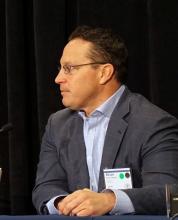BOSTON – Having a great idea is just the first step to landing a financial partner in device development – backers also scrutinize more intangible qualities.
The willingness to work as part of a team, the ability to project realistic expectations, the fortitude to take risks and persevere when circumstances get tough – these attributes are critical to forging a strong strategic alliance with a financial partner, Brian Tinkham said at the 2018 AGA Tech Summit, sponsored by the AGA Center for GI Innovation and Technology.
“Some of the brightest physician minds in the world are not the best med-tech device engineers,” said Mr. Tinkham, vice president of sales in GI Solutions at Medtronic. “When you enter the space of med-tech development, you have to join a cross-functional team. You’ll need skill sets that aren’t instinctive to you or your closed network in order to become successful.”
Put your own skin in the game
“To me, ‘skin in the game’ is mainly money. Investing your own money, your family’s money, changes the way you behave at the board meeting and when you spend that money,” Mr. Tinkham said. “We like people who are all in on this. When I see an entrepreneur who’s showing a return that’s not good enough for his own investment, I can lose confidence and trust. We want people who won’t walk away from their money, their family’s money, or my money; when times get tough and challenging, decisions need to be made.”
Be realistic
There’s a difference between confidence and irrational confidence, Mr. Tinkham said. “If you come to me presenting a game plan that says you’ll have a commercially viable product in 1 year for a $500,000 investment, you’ll shoot your credibility right off. We know exactly how hard it is to build a $10 million business, never mind a $100 million business. When you obviously don’t understand what lies ahead of you, it hurts your credibility. Work with people who have experience and let them help you present your ideas and goals in a realistic way, and that will help with raising capital so you can execute your plan.”
Be capital efficient
“The key takeaway here is that raising $100 million doesn’t necessarily make for a strong return for investors. The strong return comes with $20-$40 million raised. Most likely businesses that have raised that much have built a commercial structure, provided proof of concept with some actual sales, and generated enough customer interest to attract strategic partners.”



